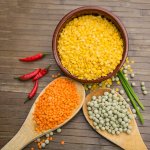World Pulses Day Date in the current year: February 10, 2026
 World Pulses Day was established by the United Nations Food and Agricultural Organization (FAO) to raise awareness of the importance of pulses (dry beans, dry peas, lentils, chickpeas, lupins) as a global food. It is observed annually on February 10.
World Pulses Day was established by the United Nations Food and Agricultural Organization (FAO) to raise awareness of the importance of pulses (dry beans, dry peas, lentils, chickpeas, lupins) as a global food. It is observed annually on February 10.Pulses, also known as legumes, are the edible seeds of the plants in the family Fabaceae that are grown for human consumption. The FAO recognizes eleven primary pulses: dry beans (kidney beans, navy beans, lima beans, adzuki beans, mung beans, etc.), dry broad beans, dry peas, chickpea, dry cowpea, pigeon pea, lentil, bambara groundnut, vetch, lupins, and minor pulses.
According to the FAO, the term “pulses” is solely applied to legumes that are harvested for dry grains. It doesn’t include legumes that are grown as vegetable crops (such as green peas and green beans), as forage crops (alfalfa, clover), or as oil crops (groundnuts and soybeans).
Pulses have been an essential part of the human diet since ancient times and are a key ingredient in many national and regional dishes. In addition to their high nutritional value and health benefits, pulses have other advantages. For example, cultivation of pulses is economically advantageous for farmers and has a positive effect on the environment.
Pulses are a rich source of protein and dietary fiber, as well as iron, zinc, B vitamins, and other nutrients. They contain no cholesterol or gluten and have a low glycemic index, making them an essential food item for vegetarians, vegans, and people with diabetes or gluten intolerance. Besides, it is hard to overestimate the importance of pulses as a source of protein in regions where meat and dairy products are physically or economically inaccessible.
Farmers benefit from cultivating pulses because they are a multipurpose crop that can be both eaten and/or sold, which creates economic stability. Besides, pulses have-nitrogen fixing properties, which improves soil fertility, and some species of pulses can be cultivated in soils with low fertility.
Pulses cultivation is also beneficial for the environment for a number of reasons. First, intercropping with pulses helps increase farm and soil biodiversity. Second, pulses have turned out to be an unexpected ally in climate change mitigation. Thanks to their nitrogen-fixing properties, farmers can use less synthetic fertilizers, indirectly reducing greenhouse gas emissions.
In 2013, the United Nations General Assembly proclaimed 2016 as the International Year of Pulses to raise awareness of the importance of pulses cultivation in achieving Sustainable Development Goals. The celebration of the year turned out a success, and Burkina Faso proposed to create World Pulses Day to be observed annually.
The initiative found support, and on December 20, 2018, the UN General Assembly adopted a resolution proclaiming February 10 as World Pulses Day. The key objectives of the day are to raise public awareness of the nutritional value of pulses and their importance as an integral part of a healthy diet, as well as to emphasize the role of pulses in the achievement of the Sustainable Development Goals.
- Category
- UN Observances
- Tags
- World Pulses Day, UN observance, FAO observance, international observance, pulses cultivation